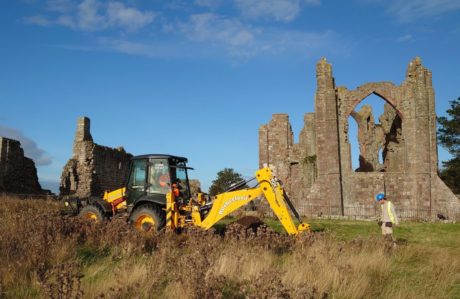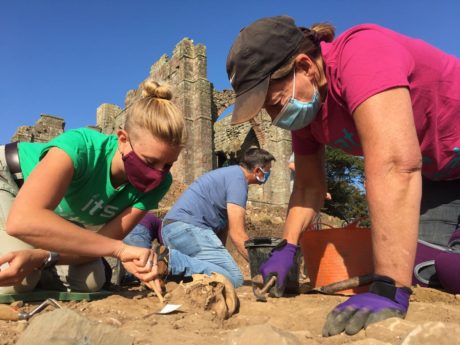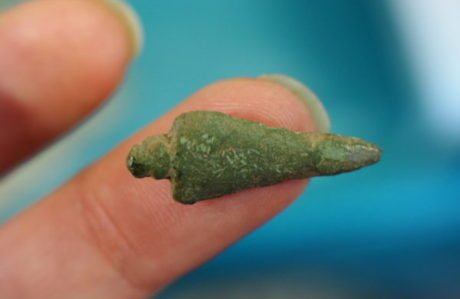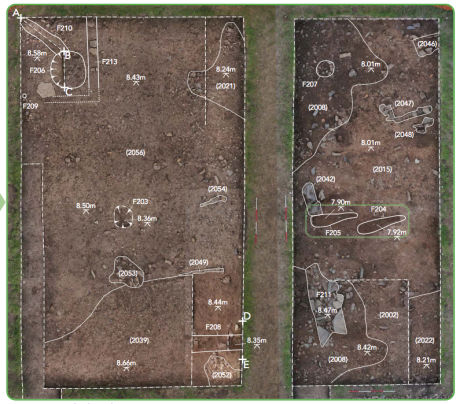
We’re back on Lindisfarne, getting ready to start our fifth season of excavation on the island so that we can continue to investigate the early medieval community who lived here before, during and after the Viking raids. Here’s what we’re hoping to find out…
Over the last four years, our crowdfunded dig with Durham University has made hundreds of exciting new discoveries about life on the island (and within the early medieval monastery which was so famously raided by Vikings) in the 8th, 9th and 10th centuries.
So far, we’ve established the location of a cemetery, where men, women and children were buried. We know that they came from near and far, were rich and poor, and that many may have travelled here to seek out medical treatments for which the island was famous.
We also think that many of them – like a woman and child – may have been ordinary islanders, rather than members of its elite religious community. Given that the lives of ordinary islanders have been largely ignored by medieval historians who were keen to record the stories of monks, bishops and saints, it’s a particularly significant discovery.
We’ve also revealed their historically undocumented burial practices – like the smooth, white quartz pebbles that were placed like flowers on the graves of some, the beautiful decorative ‘namestones’ which marked the graves of others, and the fact that most were probably buried wrapped in simple shrouds.
On top of that, we’ve shown that some people (again, probably members of the lay community) continued to live on the island after the monastic community abandoned it following the Viking raids, and that they consumed whale, seal, and all manner of fish and shellfish.
We’ve even have evidence that the monastic elite may have spent their downtime playing a North Sea version of the boardgame ‘Tafl’ in the form of a gorgeous blue glass ‘King’, which is only the second to have ever been discovered in the British Isles.
Together, all this evidence is starting to paint a vivid picture of life on the island, and the two different communities who lived here – side by side. But this year, we’ve got one particularly pressing challenge.
Over the last few seasons, our combined team of archaeologists, students, and Venturers has gradually exposed the remains of an early medieval building, along with what seems to be a huge kiln, oven or furnace, and a confusingly entangled sequence of later burials dug into the top.
Analysis of small clues, like pieces of slag and the furnace lining during last year’s excavation suggests that the furnace may have been used for metalworking – at the time, monasteries were producing all sorts of metalwork from high status objects like decorative altarpieces, to more mundane items like iron tools.
It also shows us that the furnace was probably not just used for iron working, but also for the creation of non-ferrous copper alloy artefacts, a few of which have been found in various different deposits around the site. But was the furnace inside the building? Or before the building?
What we now need to do is unpick the chronology a little further, and look for any more clues that might help us figure out what the furnace, and the building, were used for, and when.
Radiocarbon dating from the burials (who lived and died in the 11th or 12th centuries) shows that the furnace and building must be earlier than this, and therefore likely to be much earlier. Will we be able to prove that it was one of the original monastic workshops, where many of the items that attracted the Viking raiders, were produced? Or will it turn out to be something else entirely?
But that’s not all. As well as making further headway into the other areas of the dig, like the south west corner where many of the early medieval sculptures, and Anglo-Saxon namestones, have been discovered, we also want to find out more about the island itself and, to help us do it, we’ve got Karen and Raphael – two geoarchaeologists from Durham – embedded with our team.
Their research will help us to better understand the harbour – one of the most dynamic environments on the island, with the castle and the priory on either end. It will also help us to get to grips with some of the island’s other watery environments, like the central loch.
We don’t yet know if it is natural, or whether it was modified in Anglo-Saxon times or later. Raphael also wants to look at the low-lying wetlands, which have a complex history.
How were they affected by changing sea levels and the tides at certain points of prehistory? What did the landscape look like before the existing drainage system was developed in the 17th and 18th centuries, which channels water into the loch and down to the area inland from the harbour? Is there an earlier system that might have been created by King Oswald and Saint Aidan’s band of monks when they first arrived on the island? If not, how were they able to use the land?
One hypothesis is that the monks would probably have wanted to make as much use of this low-lying landscape as possible, and could have built themselves a drainage system – including the loch – as early as when they first arrived.
We’re halfway through our ten-year project, and it’s clear that this year, we’ve got big ambitions; we hope to find out more about the people who lived here, what they were doing with regards to metalworking and construction, and how they modified the island itself.
But whatever our hopes, dreams, and research ambitions, the thing we’re most looking forward to are the inevitable surprises – just like the stunning blue glass king piece from last year’s dig that survived perfectly intact for over 1,200 years. Will we manage to find anything that matches it? We’ve got two weeks to find out!


